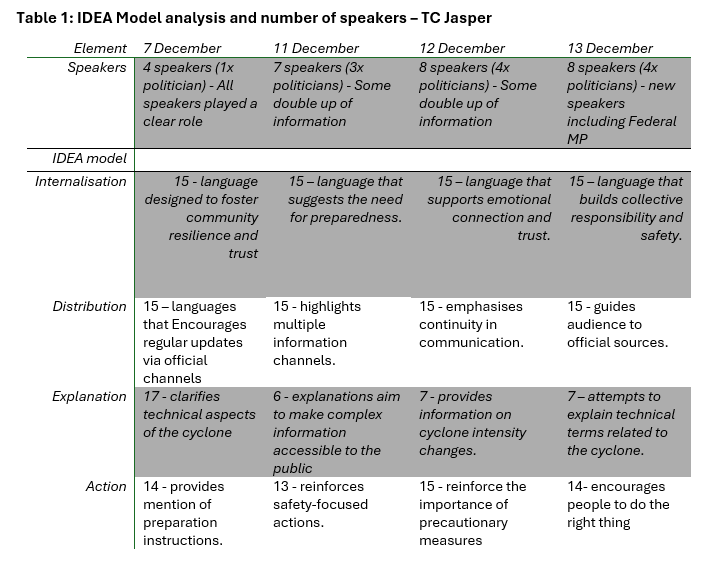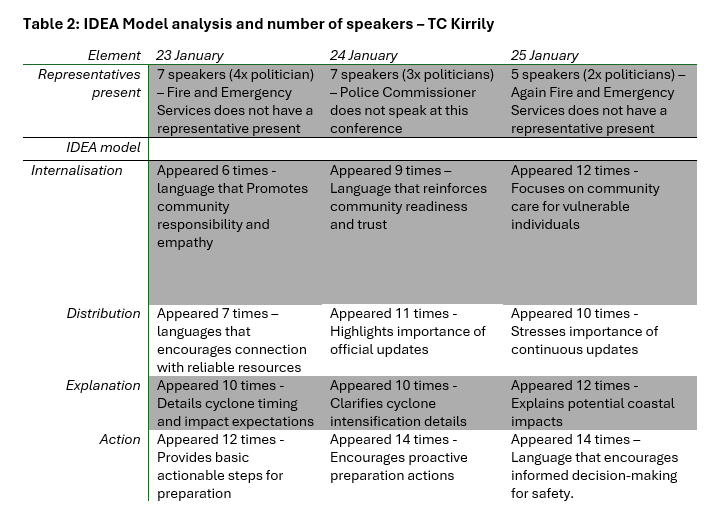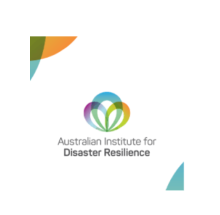During the summer of 2023–2024, Queensland faced significant tropical cyclone (TC) events that caused widespread disruption and damage. The first, TC Jasper, made landfall along the Far North Queensland (FNQ) coast on December 13, 2023, initially reaching a peak intensity of Category 4 with winds of up to 130 km/h before crossing the coast as a Category 2 system. Shortly after, on January 25, 2024, TC Kirrily struck North Queensland (NQ), having peaked at Category 3 intensity, with wind gusts reaching 120 km/h, but downgrading to Category 1 by the time it crossed the coast. Both cyclones occurred during the summer holiday season, when many travellers from across Australia and internationally visit NQ and FNQ, particularly for camping and beach holidays, amplifying the social and economic impacts of these severe weather events.
Government clarity during emergencies is crucial, as people seek guidance from state leaders (Grantham, 2023), often through media conferences that are key for public communication and political accountability (Craig, 2016; McLean & Ewart, 2020). However, communicators must use and acknowledge social media platforms when delivering public safety messages (Grantham, 2023). There has been a significant rise in the reliance on social media platforms for information and a more significant rise in the use of TikTok as one of these platforms (Lewis & Grantham, 2022). It has been described as a social media platform following an antisocial approach. Users do not need to follow an account to view content which reinforces the platform's publicness. This study scrutinises crisis communication by exploring the interaction between official government messages and the rise of TikTok as an information source during emergencies. It uses the IDEA model (Sellnow et al., 2023), a structured framework for effective risk and crisis communication that emphasises four key elements: Internalisation, Distribution, Explanation, and Action. This model guides communicators in creating messages that are clear, accessible, and actionable, ensuring public understanding and appropriate responses in emergencies. Widely applied across diverse scenarios, the IDEA model is simple and adaptable, making it a valuable tool for emergency communicators.
Seven media conferences for TC Jasper (December 7, 11, 12 and 13) and TC Kirrily (January 23, 24 and 25) were analysed using the IDEA model (Sellnow et al., 2023), revealing the involvement of 12 speakers across the two weather events, eight of which were political representatives, only four were emergency service representatives (Tables 1 and 2). A critical difference between the December and January cyclone events lies in the structure of spokesperson representation. The December event had a more streamlined approach, with fewer speakers and minimal political presence early on. For example, on December 7, only one politician was among four speakers, allowing each to share unique, focused information without redundancy. However, as the event progressed, the number of politicians increased, and overlapping information emerged, potentially sacrificing clarity. In the January event, there was a solid political presence from the start, with four politicians among seven speakers on January 23, and this pattern continued over subsequent days. Notably, representatives from emergency services, such as Fire and Emergency Services and the Police Commissioner, were often absent (Table 2). This reduced operational focus may have shifted the tone of the conferences from practical guidance to political visibility, as political figures dominated the communication space.
Queensland’s crisis communication during TC’s Jasper and Kirrily demonstrated partial application of the IDEA model, revealing effective strategies and improvement areas. Action was consistently emphasised, with clear instructions such as avoiding floodwaters and basic instructions to prepare emergency kits, while internalisation fostered emotional engagement through appeals to community resilience and safety. Notably, communication during TC Kirrily showed an enhanced clarity in explanation, with less reliance on technical jargon, making safety advice more accessible. However, gaps in distribution were evident, as the government’s minimal presence on various social media platforms limited engagement with audiences who rely on these platforms for information.
The involvement of political representatives in media briefings added complexity, blending safety messaging with political accountability and resource discussions. While their presence supported internalisation by addressing specific community concerns, it occasionally detracted from delivering focused, actionable crisis communication. These findings highlight the need for a more comprehensive application of the IDEA model, particularly in leveraging emerging platforms like TikTok to distribute clear, inclusive, and timely information during emergencies.
During both cyclone events, locals used TikTok to share their experiences. TikTok data was collected as each cyclone made landfall (TC Jasper n=50; TC Kirrily n=50). The findings highlight a significant gap in government presence, particularly during TC Jasper, where public-generated content (n=32) and content that endorses concerning behaviour (n=17) dominated, 13 of which were performed outside in the elements of the storm. Examples of these are presented in Images 1 and 2, which depict two videos that were analysed as being performed outside of the elements, the video in Image 2 is also coded as humorous.
In contrast, the TikTok content for TC Kirrily displayed a focus on informational (n=42) and educational (n=8) objectives. Education-based videos provided practical advice on cyclone readiness. There were also localised updates, often captured from residents' homes, which added a personal dimension to the event and received very high viewership, such as the video in Image 3, which received 230,000 views at the time of collection. Notably, some videos documented risky behaviour negatively, such as cyclone surfing, which introduced a unique focus on the dangers of disregarding safety advice rather than encouraging it, as we saw in TC Jasper. While user-generated content further enriched the narrative by showcasing on-the-ground realities and innovative ways of engaging with the crisis of engaging with the crisis (image 4).
The analysis of TC’s Jasper and Kirrily highlights the strengths and gaps in crisis communication across traditional and social media platforms. While official briefings provided straightforward but basic actions, the use of overly technical language and limited use of social media platforms hindered broader engagement. TikTok emerged as a dynamic tool, dominated by public-generated content that informed but risked encouraging dangerous behaviour. TC Kirrily saw greater diversity in content, emphasising education and preparation. The findings suggest the need for an integrated approach, leveraging traditional media and platforms like TikTok to deliver clear, accessible, and engaging communication during emergencies.






